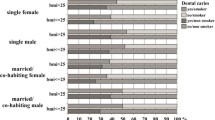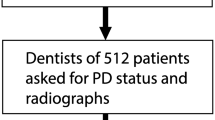Abstract
Objective
This study aims to assess the validity of four self-reported questions for measuring periodontitis in a birth cohort.
Methods
Full-mouth periodontal examinations (three sites/tooth) were undertaken at age 38 in a complete birth cohort born in 1972/1973 in New Zealand. Four self-reported periodontal screening questions were included (“Do you think you have gum disease”; “Has a dental professional ever told you that you have lost bone around your teeth”; “Have you ever had scaling, root planing, surgery, or other treatment for gum disease” and “Have you ever had any teeth that have become loose by themselves without some injury”), and the sensitivity and specificity of those self-reported items were calculated for individual questions and using a multivariable binary logistic regression model. Generalised linear models were used to compare relative risks for periodontitis and smoking, using the (a) clinical measures and (b) self-reported questions.
Results
Among the 895 who had periodontal examinations, the prevalence of periodontitis was 43.7, 22.8 and 12.0 %, respectively, for one or more sites with ≥4, ≥5 and ≥6 mm clinical attachment loss (AL). The specificity of the four self-reported questions was high (82–94 %), but the sensitivity was low for all, except the question: “Do you think you have gum disease”. The four questions’ highest combined sensitivity + specificity value was 1.33 for one or more sites with ≥4 mm AL, with the area under the receiver operating characteristic (ROC) curve being greatest for one or more sites with ≥6 mm AL, at 0.84. For the smoking–periodontitis association, the estimates of relative risk for periodontitis among smokers were as follows: (a) 1.81, 2.88 and 5.79, respectively, clinically determined to have one or more sites with ≥4, ≥5 and ≥6 mm AL and (b) 2.19, 2.17, 1.23 and 1.89, respectively, for the four self-reported questions.
Conclusion
The four self-reported periodontal screening questions performed adequately in identifying clinically determined periodontal disease, and they showed moderate validity when used together as a set. However, the strength of the association between smoking and periodontitis was underestimated when they were used instead of clinically determined periodontal disease.
Clinical relevance
These findings suggest that clinical examinations remain to be the desired approach for periodontal surveys, but where resource constraints preclude those, self-reported methods can provide useful information; after all, some periodontal information is better than none at all.
Similar content being viewed by others
References
Genco RJ, Borgnakke WS (2013) Risk factors for periodontal disease. Periodontol 2000(62):59–94
Bergstrom J (2003) Tobacco smoking and risk for periodontal disease. J Clin Periodontol 30:107–113
Blicher B, Joshipura K, Eke P (2005) Validation of self-reported periodontal disease: a systematic review. J Dent Res 84:881–890
Dietrich T, Stosch U, Dietrich D, Schamberger D, Bernimoulin JP, Joshipura K (2005) The accuracy of individual self-reported items to determine periodontal disease history. Eur J Oral Sci 113:135–140
Eke PI (2005) Public health implications of periodontal infections in adults: conference proceedings. J Public Health Dent 65:56–65
Eke PI (2009) Developing new case definitions for monitoring the nation’s periodontal health. Dent Abstr 54:63–64
Dietrich T, Stosch U, Dietrich D, Kaiser W, Bernimoulin JP, Joshipura K (2007) Prediction of periodontal disease from multiple self-reported items in a German practice-based sample. J Periodontol 78:1421–1428
Eke PI, Genco RJ (2007) CDC Periodontal Disease Surveillance Project: background, objectives, and progress report. J Periodontol 78:1366S–1371S
Genco RJ, Falkner KL, Grossi S, Dunford R, Trevisan M (2007) Validity of self-reported measures for surveillance of periodontal disease in two western New York population-based studies. J Periodontol 78:1439S–1454S
Gilbert GH, Litaker MS (2007) Validity of self-reported periodontal status in the Florida Dental Care Study. J Periodontol 78:1429S–1438S
Maas W, Genco RJ (2007) CDC Periodontal Disease Surveillance Project could help states plug data gaps. J Periodontol 78:1178
Miller K, Eke PI, Schoua-Glusberg A (2007) Cognitive evaluation of self-report questions for surveillance of periodontitis. J Periodontol 78:1455S–1462S
Taylor GW, Borgnakke WS (2007) Self-reported periodontal disease: validation in an epidemiological survey. J Periodontol 78:1407–1420
Eke PI, Page RC, Wei L, Thornton-Evans G, Genco RJ (2012) Update of the case definitions for population-based surveillance of periodontitis. J Periodontol 83:1449–1454
Eke PI, Dye BA, Wei L, Slade GD, Thorton-Evans GO, Beck JD, Taylor WS, Borgnakke WS, Page RC, Genco RJ (2013) Self-reported measures for surveillance of periodontitis. J Dent Res 92:1041–1047
Poulton R, Moffitt TE, Silva PA (2015) The Dunedin Multidisciplinary Health and Development Study: overview of the first 40 years, with an eye to the future. Soc Psychiatry Psychiatr Epidemiol. doi:10.1007/s00127-015-1048-8
Irving JC, Elley WB (1977) A socio-economic index for the female labour force in New Zealand. NZ J Educ Studies 12:154–163
Elley WB, Irving JC (1985) The Elley-Irving socio-economic index 1981 census revision. NZ J Educ Studies 20:115–128
Poulton R, Caspi A, Milne BJ, Thomson WM, Taylor A, Sears MR, Moffitt TE (2002) Association between children’s experience of socioeconomic disadvantage and adult health: a life-course study. Lancet 360:1640–1645
Goodson JM, Holtfreter B, Schwahn C (1986) Clinical measurements of periodontitis. J Clin Periodontol 13:446–455
Slade GD (2007) Interim analysis of validity of periodontitis screening questions in the Australian population. J Periodontol 78:1463–1470
Papapanou PN (2012) The prevalence of periodontitis in the US: forget what you were told. J Dent Res 91:907–908
Susin C, Kingman A, Albandar JM (2005) Effect of partial recording protocols on estimates of prevalence of periodontal disease. J Periodontol 76:262–267
Battelle Memorial Institute (1999). Evaluation of the Behavioural Risk Factor Surveillance System (BFRSS) as a source of natural estimates for selected health risk behaviours: final report. Baltimore MD
Ministry of Health (2010) Our oral health: key findings of the 2009 New Zealand Oral Health Survey. Ministry of Health, Wellington
Slade GD, Spencer AJ, Roberts-Thomson KF (2007) Australia’s dental generations: the National Survey of Adult Oral Health 2004-06. Aust Inst Health Welf Dent StatRes 34:1–100
Joshipura KJ, Douglass CW, Garcia RI, Valachovic R, Willett WC (1996) Validity of self-reported periodontal measures. J Public Health Dent 56:205–212
Buhlin K, Gustafsson A, Andersson K, Håkansson J, Klinge B (2002) Validity and limitations of self-reported periodontal health. Community Dent Oral Epidemiol 30:431–437
Swets JA (1988) Measuring the accuracy of diagnostic systems. Science 240:1285–1293
Nelson D, Holtzman D, Bolen J, Stanwyck C, Mack K (2001) Reliability and validity of measures from the Behavioral Risk Factor Surveillance System (BRFSS). Soz Praventivmed 46:3–42
Acknowledgments
We thank our study members for their continuing participation in the Dunedin Study and study founder, Dr. Phil Silva, and current director, Professor Richie Poulton. The age-26 dental data collection was supported by the New Zealand Dental Association Research Foundation and the University of Otago. The age-32 dental data collection was supported by Grant R01 DE-015260-01A1 from the National Institute of Dental and Craniofacial Research, National Institutes of Health, Bethesda, Maryland, 20892, USA, and a programme grant from the New Zealand Health Research Council (NZ HRC). The age-38 data collection was supported by a programme grant from the NZ HRC. The Dunedin Multidisciplinary Health and Development Research Unit is supported by the NZ HRC.
Conflict of interest
The authors declare they have no competing interests.
Compliance with Ethical Standards
The research involves humans and has ethical approval from the Lower South Regional Ethics Committee LRS/10/03/012.
Author information
Authors and Affiliations
Corresponding author
Rights and permissions
About this article
Cite this article
Foster Page, L.A., Thomson, W.M. & Broadbent, J.M. Validity of self-reported periodontal questions in a New Zealand cohort. Clin Oral Invest 20, 563–569 (2016). https://doi.org/10.1007/s00784-015-1526-0
Received:
Accepted:
Published:
Issue Date:
DOI: https://doi.org/10.1007/s00784-015-1526-0




